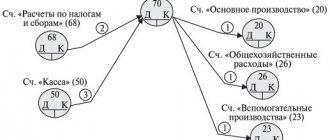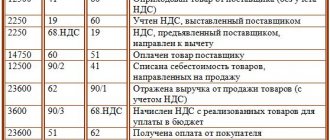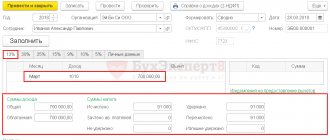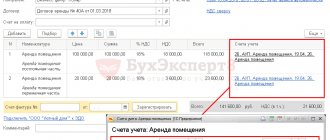Placing money on deposit - what is it?
If an organization generates free funds, then so that they do not lie like a dead weight on the current account, the organization can make them work.
Thus, money not involved in circulation can generate additional income. One of the ways to obtain such income is to place funds on deposit. A deposit account is an account in a banking institution in which a person places available funds, and the bank, according to the terms of the signed agreement, accrues interest on them in the established amount. Typically, deposit agreements are concluded for a specific period. Upon expiration, the funds are returned to their owner. Funds can only be credited to this account as a deposit.
IMPORTANT! The deposit account is not intended for settlements with third parties.
Accounting accounts for recording deposits
Placing funds on deposit gives the organization income in the form of interest. Transactions with funds that generate income are called financial investments, for which account 58 “Financial investments” is provided in the working chart of accounts. However, account 58 only takes into account financial investments in the form of shares and shares, debt securities, deposits under a simple partnership agreement and loans provided.
Accounting for deposits, according to the chart of accounts, must be kept on account 55 “Special accounts in banks”, to which additional sub-accounts are opened:
- 55.01 - letters of credit;
- 55.02 - check books;
- 55.03 - deposit accounts.
Analytical accounting of bank deposits is carried out for each deposit agreement separately.
Depending on the conditions, deposit agreements can be divided into two categories: with interest capitalization and without interest capitalization.
Let's look at the accounting entries in both cases.
Which accounts are involved in accounting entries for accounting for deposit transactions?
The deposit account refers to the so-called special accounts in the bank, for the accounting of which account 55 is intended in the accounting department. The Chart of Accounts (approved by order of the Ministry of Finance of the Russian Federation dated October 31, 2000 No. 94n, as amended on November 8, 2010) provides for several sub-accounts for this account. Deposits are accounted for in subaccount 55.3 “Deposit accounts”.
Since deposits are recognized as financial investments in accordance with clause 3 of PBU 19/02, they can also be taken into account in account 58 “Financial investments” by opening the corresponding sub-account.
NOTE! The organization establishes the method of accounting for the movement of money on deposit in its accounting policy.
Accounts 55 and 58 are active, so an increase in funds on deposit will be by debit, and a decrease in the deposit account or returned to the owner to the current account will be by credit.
As for the entries on the receipt of interest on the current account and, accordingly, their accrual, account 91 “Other income and expenses” will be involved in them. Subaccount 1 to this account “Other income” is intended to reflect various income, including interest received, from activities not related to the main one.
The terms of the bank deposit agreement may affect taxes and accounting for the depositor. Find out how to check the wording of the contract from the Transaction Guide from ConsultantPlus. Get trial access to the K+ system and study the material for free.
Accounting accounts for deposits and interest
The deposit account in accounting is assigned to a special account, which is recorded on “Account-55” of the chart of accounts.
“Account-55” “Special accounts in banks” is intended to summarize information on the availability and movement of funds in the currency of the Russian Federation and foreign currencies located on the territory of the Russian Federation and abroad in letters of credit, check books, and other payment documents (except bills of exchange) , on current, special and other special accounts, as well as on the movement of funds for targeted financing in one or another part that is subject to separate storage.
Sub-accounts can be opened for “Account-55”; for deposit funds, sub-account 55.3 “Deposit accounts” is provided.
Subaccount 55.3 takes into account the movement of funds invested by the organization in bank and other deposits.
In addition to account 55.3, deposits can be accounted for in account 58 “Financial investments”, since these deposits are recognized as financial investments in accordance with paragraph 3 of “PBU-19/02”, in this case a corresponding sub-account is opened for “Account-58” 58.5-“Bank deposits (deposits)”.
Please pay attention! Accounting for deposit funds is fixed in the company's accounting policy.
Interest accrued on the deposit - accounting entry and its significance for tax accounting
As we have already noted, the frequency of interest calculation, as well as their rate, is one of the mandatory conditions of the contract. When calculating interest from an organization that owns funds on the basis of bank documents, the following entry must be generated:
Dt 76 Kt 91.1.
Interest on deposits must be taken into account as non-operating income when calculating income tax if the organization applies the main regime, or a single tax under the simplified tax system as they are accrued (or received) - clause 6 of Art. 250 Tax Code of the Russian Federation.
Interest can be transferred to a person’s current account as it accrues, or it can accumulate in a deposit account and be paid in a lump sum only upon expiration of the contract. The transfer of interest to the current account will be reflected in correspondence:
Dt 51 Kt 76.
You can confirm our conclusions in the Ready-made solution from ConsultantPlus. If you do not have access to the K+ system, get a trial online access for free.
Accounting for interest on deposits in transactions
Interest on the deposit, which is accrued every month, is included in the section of other income of the organization. They must also be displayed in accounting on a monthly basis until the term of the banking agreement expires. According to the accounting regulations, “organizational income”:
- The accrual of interest on the deposit is reflected in the debit of account No. 76 “settlements with various creditors and debtors”.
- When creating a posting, account credit No. 91 “other expenses, income” or No. 91.01 “other income” is used.
For tax purposes, the amount placed in a deposit bank account will not be considered an expense of the enterprise, just as it will not be considered income when the money is returned to the depositor.
Results
The company can place funds on deposit to receive additional income. In accounting, entries will appear using account 55 or 58, which will reflect transactions of transferring money to the deposit and their return, and account 91.1, where the interest accrued by the bank in favor of the owner of the funds will be recorded as part of other income.
The article presented the main accounting entries that should appear in accounting when reflecting transactions on deposit accounts.
Sources:
- Order of the Ministry of Finance of the Russian Federation dated October 31, 2000 N 94n
- Tax Code of the Russian Federation
You can find more complete information on the topic in ConsultantPlus. Free trial access to the system for 2 days.
Accounting entries for the deposit when opening and closing it
In accordance with PBU 19/02 (clauses 2, 3), deposit funds in accounting are shown as financial investments. They are registered at their original cost, which is the amount of money deposited in a bank account.
To account for the deposit, according to the Chart of Accounts, two accounts can be used:
- account 58 intended for financial investments;
- account 55 reflecting funds in special accounts in banking institutions.
Subaccounts are opened for these accounts: 58-5 “Bank deposits (deposits)” and 55-3 “Deposit accounts”. The method chosen by the enterprise to account for the movement of money on the deposit must be fixed in the accounting policy.
When opening a bank deposit and returning money from it, you must use the following transactions:
| Contents of operation | Dt | CT |
| Crediting money to a deposit | 58 (55-3) | 50, 51, 52, etc. |
| Closing the deposit | 50, 51, 52, etc. | 58 (55-3) |
Attention! Regardless of the chosen option for accounting for deposits (on account 55 as cash or on account 58 as part of financial assets), they must be reflected in the reporting as financial investments (clause PBU 19/02).
Errors in the process of accounting for deposit transactions
Very often, after an audit or internal bank inspection, the following errors are observed in the management and accounting of deposit transactions:
- Errors in bank deposit agreements;
- Discrepancy in the timing of recording funds in accounts with the deadlines specified in the deposit agreement;
- Lack of documents that determine the accounting procedure for deposit transactions;
- Untimely accrual or non-accrual of funds from the deposit account to the demand account, in the event of expiration of the contract;
- Incorrect calculation of interest on the deposit;
- Carrying out deposit operations of legal entities using cash.
Do you need proofreading or review of academic work? Ask a question to the teacher and get an answer in 15 minutes! Ask a Question
Deposit operations with the participation of the Central Bank
Transfer of funds to an account opened with the Central Bank:
- Debit – 31901 – (demand deposits);
- Loan – 30102 – (bank correspondent account).
Accrual of interest on deposit:
- Debit – 47427 – (requirements for payment of interest on deposit);
- Credit – 70601 – (income).
Transfer of deposit amount and interest to a commercial bank
- Debit – 30102 – (bank correspondent account);
- Loan – 31901– (demand deposits).
How is interest calculated on deposits with capitalization?
In addition, the most important concept for calculating and calculating interest on a deposit is the concept of interest capitalization. Capitalization works according to the following system:
- a reporting period for calculating interest on the principal amount of the deposit is established (for example, 30 days);
- the interest capitalization period is established (for example, also 30 days);
- after 30 days, accrued interest is capitalized, i.e. are added to the principal amount of the deposit;
- in the next reporting period (next 30 days), interest will be calculated on the principal amount of the deposit together with interest for the previous month, i.e. in fact, the principal amount of the deposit is constantly growing, as is the accrued interest.
It is precisely due to the fact that the total amount of interest depends on the principal amount of the deposit, and this amount constantly increases during capitalization, such deposits in banks with monthly interest payments and capitalization are often more profitable than deposits with a high interest rate and interest payment only at the end term.
An alternative option is the so-called “manual capitalization”: if replenishment of the deposit is allowed, then you can independently increase its principal amount, which will lead to an increase in income from the deposit.
All conditions for calculating interest are specified in the deposit agreement. Before concluding an agreement and choosing a specific type of deposit, you need to calculate all the options offered by the bank, as well as assess your financial situation from the point of view of the need to quickly receive interest. To calculate the return on your deposit, we suggest using a deposit calculator.
Interest on deposit: accounting entries
To account for interest accrued on the deposit, subaccount 91-1 “Other income” is used. They are reflected differently depending on the accrual method specified in the agreement with the bank: simple or complex (with capitalization).
When calculating simple interest, account 91-1 corresponds with account 76 “Settlements with other debtors and creditors.” When calculating interest on a deposit, the following entries must be made:
- Dt 76 Kt 91-1 – interest is accrued on the deposit;
- Dt 51 Kt 76 – accrued interest is credited to the company’s account.
With compound interest, the deposit amount increases. In accounting, they belong to other income and are shown in account 91-1 in correspondence with the selected account for the deposit itself: 55 or 58. When capitalizing (attaching to the deposit amount) accrued interest, the income on them is recorded as follows: Dt 58 (55-3) Kt 91-1.
Accounting for deposit operations of legal entities
For accounting of deposit operations of legal entities, the following accounts are used:
- from 410 to 422 – deposits of legal entities. These accounts are passive.
- 425 – deposits of non-resident legal entities.
- from 427 to 440 – other funds raised.
When opening an account, a deposit agreement is concluded between the bank and the client. Such an operation is formalized with the following posting:
- Debit – 401 – 408 (funds in bank accounts);
- Credit – 410 – 422 (deposits of legal entities).
Closing of the deposit is carried out by reverse posting.
If the client’s account is opened in another bank, then the following posting is made:
Have questions about this topic? Ask a question to the teacher and get an answer in 15 minutes! Ask a Question
- Debit – 30102 (credit organizations);
- Credit – 410 – 422 (deposits of legal entities).
Closing of the deposit is carried out by reverse posting.
Payment of interest on the deposit is reflected in the following way:
- Debit - 47426 (payment of interest on deposit);
- Credit - 20202 (Bank cash desk).
The accrual of interest on the deposit is documented by posting:
- Debit - 47426 (payment of interest on deposit);
- Credit - 410-422 (Deposits of legal entities).
These are the main accounting entries for deposit operations of legal entities.









